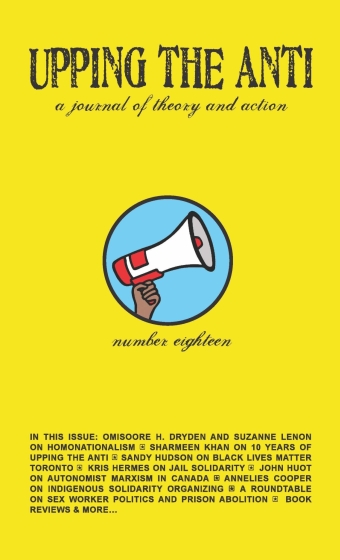Can Urban Indigenous Peoples Defend the Land?
Dear UTA,
Freda Huson, Toghestiy, and the rest of the Unist’ot’en Camp invoke some foundational tensions in Indigenous decolonial thought as to what “the city” means for a decolonized future on Turtle Island. It is now a truism that more Indigenous peoples in Canada are living in urban areas than “on the land.” A major and relatively recent transition in Indigenous ways of life is being reckoned with in countless experimentations in cities across the country. To be sure, the fact that over 50 percent of Indigenous peoples live in urban areas papers over an extreme diversity in Indigenous urban lives – many folks have patterned circulations between urban and less urban places, while others have never really left the city.
When land defenders carrying out the type of full reoccupation of traditional territories that Unist’ot’en has been able to achieve speak of responsibility, it is often packaged with a vision of the city that resonates with the historic detractors of urban life. The city in this framework is the beating heart of the beast of global capitalism – those who live within its clutches are stripped of ancestral meanings and associations, and are left as alienated wage-slaves overwhelmed by urbanity. The responsibility of Indigenous peoples, then, is to loosen these shackles, return to the land, and resume those ancestral practices responsible for its care, becoming a living frontline defense force. Our hemispheric history is replete with epic stories of such defense, which act as a call to arms for a robust pan-Indigenism. Many others feel the city and urban Indigenous peoples can not only play a key role in producing such land defense effects, but should be understood as a necessary theoretical, spiritual, and political lens in framing a more comprehensive decolonial praxis.
I’m thinking of Elder Vern Harper, a Cree elder raised in Toronto’s Regent Park, now in his 80s, who helped found the concept of the “urban elder.” Elder Vern, like so many Indigenous folks before and after him, was urbanized through genocidal forces – in his case, by being stolen by the foster system as an infant and dropped into the dregs of downtown Toronto.
Whether urbanized through simple primitive accumulation, or by more complex state mechanisms to destroy Indigenous communities (such as residential schooling), or by not feeling they could survive in more rural places, Native folks are taught and healed by Vern in Toronto’s Indigenous community. Huge segments of Native Toronto can’t call Toronto traditional territory, but are still focused on struggling here for reparations, resurgence, decolonization, and land defence.
Urban spaces, more so than any others, make us routinely encounter those who are different from us, and in ways that don’t necessarily lead to a predictable outcome. Indigenous places like Toronto have forced Native migrants, like other migrants and settlers who call Toronto home, to reconcile their lifeworlds – their ceremonies, their languages, their land knowledges, their colonial present – with not only a brutally dominant society, but the inherent intangibility of urban space.
Urban spaces, as they currently stand, cannot support most traditional Indigenous economies, and as such are not often valued as land to be defended. Folks like Elder Vern have taken that challenge head-on, making the city a place to begin a decolonial transition for Native lives in crisis, facilitating resurgence through land-based spiritual recovery. In conversation with Elder Vern, whose teachings and guidance has saved hundreds of lives from many nations, you get a sense of an older pan-Indigenism that was born exactly at the time when Indigenous peoples were being urbanized in record numbers (the 1950s and ’60s). That Indigenism honoured and respected traditional territories as a means to recover what had been lost, but also reflected and recognized the urban conditions – the confrontation of so much difference, even if segregated into the Native ghettos of Turtle Island – that had helped generate their consciousness. For instance, the American Indian Movement (of which Elder Vern was once a key member) understood part of that urban awakening of consciousness as transcending purely Indigenous lines, as seen in their intensive collabouration with non-Native decolonization movements (and particularly with the Black liberation struggle).
Even as we should, of course, bolster “frontline” land defence such as the Unist’ot’en Camp, we should push ourselves further to consider what urban Indigenous life (now a dominant mode of Indigenous life on Turtle Island) has meant for our collective understanding of decolonial praxis. Our mutually implicated lives are nowhere more obvious than the city. We should consider how the urban experience has forced us to confront each other in unexpected ways; produced new horizons for solidarity, identification, and resistance; and worked in productive tension with the decolonization protocol that calls for traditional nations to defend traditional lands.
In Solidarity,
Nate Prier
Toronto, ON

